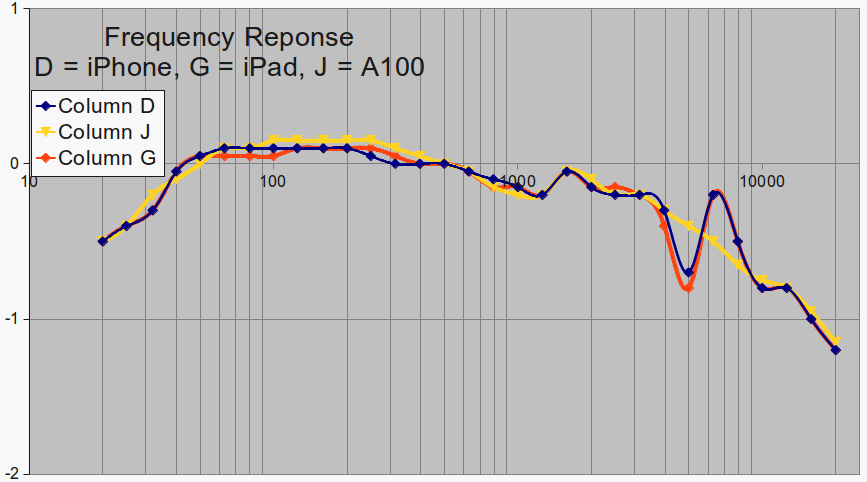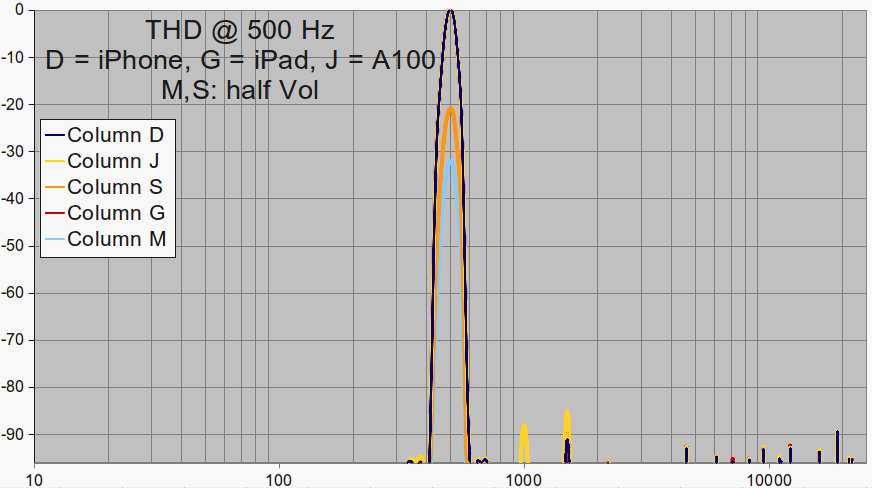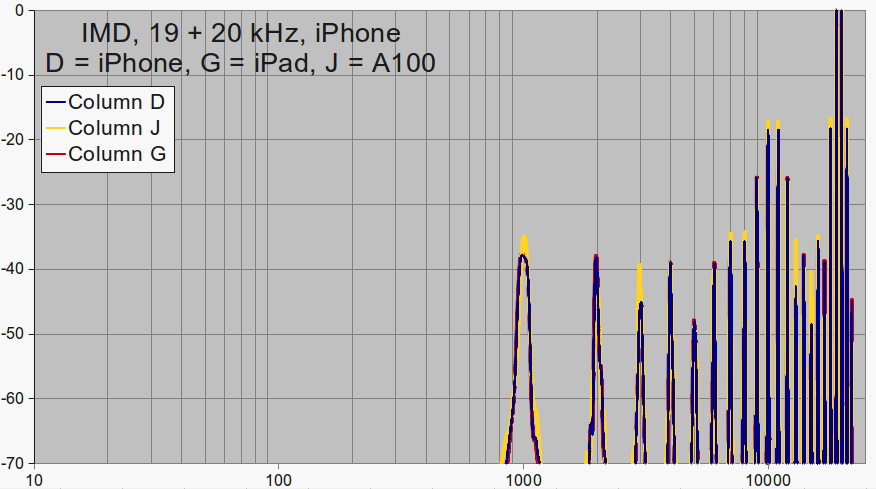
I've always enjoyed the high sound quality from the headphone jack of my iPad & iPhone. With all EQs turned off, it sounds similar to a full size stereo component. I recently got an Acer A100 Honeycomb 3.2 tablet and it too has very good subjective sound quality. A few weeks ago I rang out my iPhone & iPad with signals on my virtual bench. This weekend I added the Acer A100 for comparison. Here's the results.
NOTES
I used test signals from Stereophile test discs 1 through 3. Most of the signals came from test disc 2, which is the most useful one for ringing out equipment on my virtual bench.
I copied the raw WAV files directly onto the devices - no conversion to MP3. The files are computer generated, not recorded, so the WAV files themselves are mathematically perfect. That is, all forms of distortion are nonexistent in the raw WAV files.
All devices measured - had battery status 50% or higher, and all other apps were terminated for the test.
I used a plain old vanilla Sound Blaster card for hardware. The measurements made here are not corrected; they do include the card's inherent distortion. This card is cheap but measures better than it has a right to, given its low price. It's comparable to most full size high quality audio gear. I used Audacity 1.3.13 on Ubuntu 11 to measure the results, and LibreOffice Calc to generate the graphs.
FREQUENCY RESPONSE
This form of distortion is perhaps the most easily audible to untrained listeners.
Overall score: very good: 4 / 5.
The Acer is slightly better than the Apple devices, but the differences are not likely to be audible.

Note the scale: it is very tightly zoomed in. All devices are within 1 dB of perfectly flat response through virtually all of the audible spectrum. The Apple devices' sharp narrow dip at 5 kHz is strange, but at 0.5 dB it's inaudible. The Acer has a perfectly linear rolloff. The HF rolloff that both devices exhibit is not a big deal because:
I also created an MP3 version of top half of the frequency range. This is to test whether the devices applied bandwidth filtering to MP3. Many devices do, but none of these did. They had the exact same full bandwidth response in MP3 as they did in WAV.
HARMONIC DISTORTION
This form of distortion is usually inaudible to untrained listeners,
but easily picked up with some training what to listen for.
Overall score: great: 5 / 5.
The Apple devices are slightly better than the Acer, but the differences are not likely to be audible.

As you can see from the graph, the test tone is a pure 500 Hz sine wave. The Y scale is 96 dB - full CD resolution. On the Apple devices, the strongest harmonics at 1,500 and 19,000 are about -90 dB below the signal. On the Acer, the strongest harmonics at 1,000 and 1,500 are about -85 to -88 dB below the signal. This is excellent and totally inaudible, comparable to a good high end audio component.
I tested this twice, the 2nd time using half volume on each iOS device. That's the light blue line. This is because I've seen digital volume controls on other devices create distortion. On the Apple devices, reducing to half volume dropped the level by -32 dB, on the Android, half volume dropped the level by -20 dB, and neither showed any increase in distortion. The volume controls on both devices are properly implemented.
INTERMODULATION DISTORTION
This kind of distortion is the most difficult to hear.
And the test signal used is something that would never occur in any normal listening,
designed to exacerbate any bugs or limitations in the finest D/A converters.
It is 19 kHz and 20 kHz played at full scale amplitude (0 dB).
Overall score: poor: 2 / 5.

As you can see, the devices didn't fare so well here. Theoretically, the spectrum should show spikes at 19 kHz and 20 kHz with everything else at -96 or lower. Every other tone in this spectrum is a difference signal, distortion that should not exist. The strongest are about -20 dB below full scale, which is easily audible. There are about 20 artifacts here and all of them are at audible levels.
I also measured this with the signals at -1 dB. Sometimes, lowering the signal levels by 1 dB drops the distortion significantly. This is due to non-linearities in some D-A converters as they go near full scale. But on these devices, this made no measurable difference.
By comparison, a really good CD player like the Onkyo DX-7555 has much lower IMD with the strongest artifacts about -60 dB below signal. And at -1 dB the strongest artifacts drop to -80 dB or lower. dB is logarithmic, and the difference: 40 dB is a ratio 100:1. That is, the iPad & iPhone have IM distortion at least 100 times higher than a good CD player. That said, this high level of IMD is typical of portable devices I've measured, and is not likely to be audible on any normal content, whether music or movies.
SUMMARY
Overall, these devices have very good sound quality, both objectively and subjectively. It is not as good as a high quality full size audio component, but more than sufficient for the content & environments in which they are typically used. I have seen a few full size "audiophile" components that measure worse than these portable devices. Subjectively, the sound is clear and clean, detailed and neutral (neither warm or cold). The 'phone & 'pad are virtually identical in their strong areas and their flaws, which suggests they have the exact same D/A converters and op-amps. The Acer is slightly different and clearly does not have the same internals. It has slightly better frequency response and slightly higher distortion, but the differences are small and inaudible to virtually all listeners.